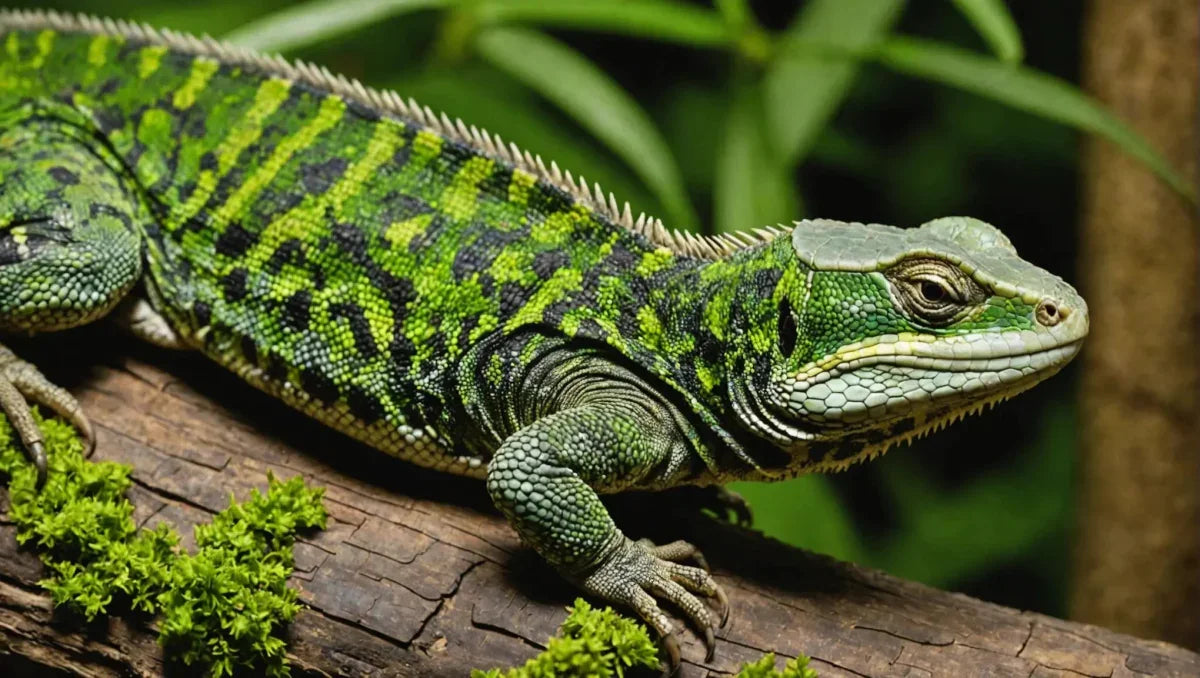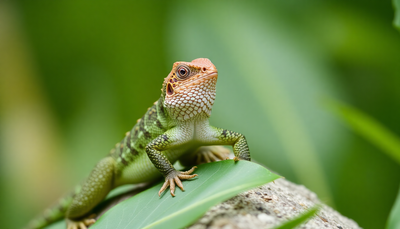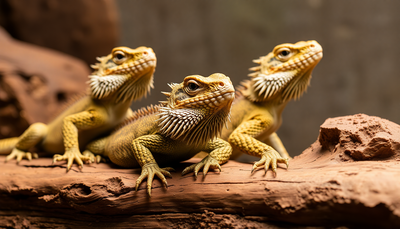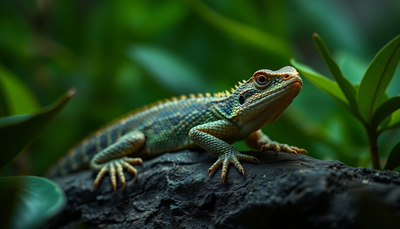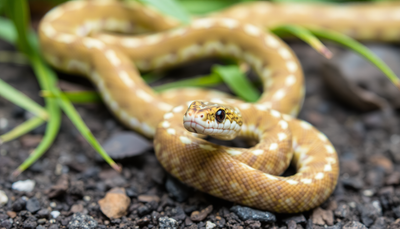
Welcome to the world of reptile care! Enhancing your reptile's diet with live reptile food is a crucial aspect of ensuring their health and well-being. In this guide, we will explore the benefits of incorporating live prey into your reptile's feeding routine, the types of live reptile food available, and how to safely introduce these options to your scaly companion. By understanding the nutritional needs of your reptile and providing a varied diet that includes live food, you can help mimic their natural feeding behaviors and promote a more enriched and fulfilling life for your pet. Whether you have a bearded dragon, a gecko, a snake, or any other reptile friend, this guide will equip you with the knowledge and tools to take your reptile's diet to the next level. Get ready to dive into the world of live reptile food and watch your scaly friend thrive!.
Caring for Pet Reptiles with Live Food
When it comes to caring for pet reptiles, providing a well-rounded diet is essential for their health and overall well-being. Live reptile food plays a crucial role in meeting the specific dietary requirements of various reptile species. Understanding the nutritional benefits of different types of live food can empower reptile owners to make informed decisions about their pets' diets.
Types of Live Reptile Food
-
Crickets: These small insects are not only rich in protein and fiber but also serve as an excellent source of essential nutrients for insect-eating reptiles. Crickets are widely accepted by many reptiles and are a staple food for species like bearded dragons and chameleons.
-
Mealworms: High in fat and protein, mealworms are a popular choice for reptiles needing a high-energy diet. They are commonly fed to a variety of reptiles, including leopard geckos and various lizard species.
-
Superworms: Larger than mealworms, superworms are also high in protein and fat, making them suitable for larger reptile species such as monitors and tegus. These worms provide a substantial nutritional boost for reptiles with higher energy requirements.
-
Dubia Roaches: Known for being a good source of protein and calcium, dubia roaches are highly beneficial for reptiles that require additional calcium supplementation in their diet. They are a preferred choice for many reptile owners due to their nutritional value.
-
Hornworms: With their high moisture content and low fat levels, hornworms are an excellent hydrating option for reptiles, especially those that may not readily drink water. They are a great choice for maintaining hydration levels in reptiles.
-
Waxworms: While high in fat, waxworms serve as a calorie-dense treat that can be offered occasionally to reptiles needing extra calories. However, due to their high-fat content, waxworms should be fed sparingly to prevent excessive weight gain.
Each type of live food offers specific nutritional benefits tailored to meet the dietary requirements of different reptile species. It is crucial for reptile owners to provide a varied diet to ensure a balanced nutritional intake for the optimal health and longevity of their beloved reptilian companions.
In addition to the mentioned live reptile foods, there are other options available in the market that cater to specific dietary needs. Phoenix worms, also known as calciworms, are rich in calcium, making them an excellent choice for reptiles requiring calcium-rich diets. Silkworms are another nutritious option, offering a good source of protein and low-fat content, suitable for various reptile species. Butterworms, although high in fat, are a favorite treat for many reptiles due to their soft bodies and palatability.
Considerations for Feeding
When selecting live food for your reptile, it is essential to consider not only the nutritional content but also the size of the prey relative to your pet's size. Feeding appropriately sized prey helps prevent choking hazards and ensures your reptile can consume its food safely.
Moreover, gut-loading, a process of feeding nutritious foods to live prey before offering them to your reptile, can enhance the nutritional value of the feeder insects. By gut-loading, you can pass on additional vitamins and minerals to your reptile, promoting its overall health.
Remember, a diverse diet is key to providing comprehensive nutrition for your reptile. By incorporating a variety of live foods and supplementing with fresh fruits and vegetables, you can create a well-rounded meal plan that supports your reptile's growth and vitality.
How to Safely Incorporate Live Reptile Food
Introducing live food into your reptile's diet can be a rewarding experience that not only provides essential nutrients but also stimulates natural hunting instincts. However, it's crucial to approach this aspect of reptile care with caution and responsibility. Here are some comprehensive guidelines to help you successfully incorporate live food into your reptile's diet:.
Selecting Quality Live Food Sources:
- Choose live food from reputable suppliers known for providing healthy and nutritious options for reptiles. This ensures that the food is free from harmful chemicals or parasites that could endanger your pet.
- Consider breeding your own live food, such as crickets or mealworms, to have full control over their diet and ensure they are gut-loaded with essential nutrients before feeding them to your reptile.
Quarantine and Observation:
- Before introducing live food to your reptile, quarantine them for a period of time to observe their behavior and ensure they are active and healthy. This step helps prevent the spread of potential diseases to your pet.
- Monitor your reptile closely during feeding to ensure they are consuming the live food promptly. Remove any uneaten food to prevent it from causing stress or injury to your reptile.
Feeding Frequency and Variety:
- Tailor the feeding schedule based on your reptile's species, age, and individual dietary requirements. While some reptiles may thrive on a diet of live food multiple times a week, others may have different needs.
- Offer a variety of live food options to prevent dietary deficiencies and keep your reptile engaged. Experiment with different insects, worms, or even small rodents (for larger reptiles) to provide a balanced diet.
Portion Control and Monitoring:
- Avoid overfeeding your reptile with live food, as this can lead to obesity and other health issues. Adjust the portion size based on your pet's size and activity level to maintain a healthy weight.
- Regularly assess your reptile's body condition and adjust the feeding regimen accordingly. Consult with a reptile veterinarian if you have concerns about your pet's diet or weight.
By following these detailed guidelines and continuously monitoring your reptile's dietary needs, you can ensure that live food becomes a beneficial and enriching part of their diet. Remember, a well-rounded diet contributes to your reptile's overall health and well-being, promoting longevity and vitality.
DIY Live Food Cultivation
Are you tired of constantly buying live food for your reptiles? Why not try cultivating your own at home? Not only is it cost-effective, but it also ensures that your reptiles are getting the freshest and healthiest food possible. In this blog section, we will provide you with a comprehensive guide on how to cultivate live food at home for your scaly friends.
Benefits of Growing Your Own Live Food
-
Cost-Effective: By growing your own live food, you can save money in the long run compared to purchasing it regularly.
-
Quality Control: You have full control over the quality of the live food, ensuring that your reptiles are consuming nutritious and healthy meals.
-
Convenience: Having a constant supply of live food at home means you don't have to make frequent trips to the pet store.
-
Sustainability: Cultivating your own live food promotes sustainability by reducing the carbon footprint associated with transportation and packaging.
Get ready to embark on a rewarding journey of DIY live food cultivation for your beloved reptiles!.
Guide on Cultivating Live Food at Home for Reptiles
If you're looking to take your reptile care to the next level, cultivating live food at home is a fantastic option. Not only does it provide numerous benefits for your scaly companions, but it can also be a fulfilling and educational experience for you. Here's a step-by-step guide to help you get started:.
-
Choosing the Right Live Food Species: Depending on the type of reptiles you have, you'll need to select appropriate live food species to cultivate. Common options include crickets, mealworms, and dubia roaches.
-
Setting Up a Cultivation Station: Create a designated area in your home for cultivating live food. This could be a plastic container, a terrarium, or a small bin with proper ventilation and substrate.
-
Providing Proper Nutrition: Just like your reptiles, the live food you cultivate also requires proper nutrition. Ensure they have access to a nutritious diet to pass on those benefits to your pets.
-
Maintaining Optimal Conditions: Regularly check the temperature, humidity levels, and cleanliness of the cultivation station to ensure the live food thrives and remains healthy.
-
Harvesting and Feeding: Once your live food colony has grown, harvest them as needed and feed them to your reptiles. This ensures a fresh and nutritious meal for your scaly friends.
By following these steps and investing time and effort into cultivating live food at home, you'll not only save money but also provide your reptiles with the best possible nutrition. Get ready to witness the joy of seeing your reptiles enjoy a meal that you've nurtured from start to finish!.
Precautions and Considerations
Feeding live food to your pets can be a great way to provide them with a natural and enriching diet. However, it is essential to take certain precautions to ensure the safety of both your pets and yourself. Here are some important points to consider when feeding live food:.
-
Quality of Live Food: Ensure that the live food you are feeding to your pets is of high quality and free from any parasites or diseases.
-
Size of Live Food: Make sure that the size of the live food is appropriate for your pet's size and species. Feeding food that is too large can pose a choking hazard.
-
Supervision: Always supervise your pet while they are feeding on live food to prevent any accidents or injuries.
-
Avoid Overfeeding: Overfeeding live food can lead to obesity and other health issues in your pets. Follow a feeding schedule recommended by your veterinarian.
-
Hygiene: Maintain proper hygiene practices when handling live food to prevent the spread of bacteria or parasites.
In addition to these precautions, it is important to be aware of the potential risks associated with feeding live food and how to mitigate them:.
-
Risk of Injury: Live food, such as insects or small rodents, can potentially bite or scratch your pet during feeding. Be cautious and handle live food carefully.
-
Allergic Reactions: Some pets may have allergic reactions to certain types of live food. Monitor your pet for any signs of allergic reactions and consult your veterinarian if needed.
-
Disease Transmission: Live food can carry diseases that can be transmitted to your pets. Purchase live food from reputable sources and quarantine them if necessary.
-
Nutritional Balance: Ensure that the live food you are providing offers a balanced diet for your pet. Consult with a veterinarian or a pet nutritionist to determine the appropriate variety and quantity of live food.
-
Environmental Enrichment: Feeding live food can also serve as a form of environmental enrichment for your pets. Consider incorporating interactive feeding methods or puzzles to stimulate your pet's natural foraging instincts.
By taking these precautions and being aware of the potential risks, you can safely feed live food to your pets and provide them with a varied and stimulating diet that promotes their overall well-being.
The provided topic: Enhance Your Reptile's Diet with Live Reptile Food
Incorporating live reptile food into your pet's diet can significantly enhance their overall health and well-being. By providing a more natural and stimulating feeding experience, live prey items can help fulfill your reptile's nutritional needs while also promoting their natural hunting instincts. Remember to always research and select appropriate live food options based on your reptile's species and individual dietary requirements to ensure a balanced and enriching diet.


